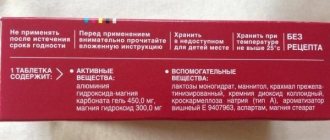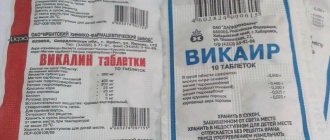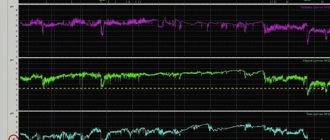Pharmacological properties of the drug Gastal
a buffer antacid that reduces the increased acidity of gastric juice and eliminates the unwanted reactions it causes (pain, heartburn, etc.). The optimal ratio of active components in the composition of the drug ensures the antacid effect of Gastal, characterized by a decrease in acidity to a certain extent, as well as a quickly onset and long-lasting effect (within 2 hours). The gel of aluminum hydroxide and magnesium carbonate is a buffer antacid substance that reduces the increased acidity of gastric juice to physiological limits (pH 3.0–5.0) and thus ensures a normal digestion process without subsequent hypersecretion. Aluminum hydroxide adsorbs and precipitates pepsin in gastric juice, reversibly inactivating it. Magnesium hydroxide is a non-absorbable, non-buffered antacid. It has a pronounced, quickly-onset and long-lasting neutralizing effect, in addition, it exhibits a laxative effect. In combination with aluminum hydroxide, it enhances the antacid effect and reduces the likelihood of constipation. Aluminum hydroxide, after reacting with hydrochloric acid of gastric juice in an alkaline environment, forms compounds with phosphates and carbonates and is excreted in the feces in the form of insoluble salts. After a chemical reaction, magnesium hydroxide is excreted from the body in feces, also in the form of insoluble salts. In patients with normal renal function, Gastal does not have a systemic effect, since it is absorbed in the digestive tract in very small quantities and is quickly excreted in the urine.
special instructions
Tetracycline antibiotics should not be taken together with antacids.
It is prohibited to take antacids and tetracycline antibiotics. Absorption of tetracycline is reduced by 90%. The antibiotic can only be taken 2 hours after the antacid.
Cephalosporin and cyclofloxacin drugs lose their effectiveness by 50–90% in the presence of Gastral.
The antacid reduces the effectiveness of acetylsalicylic acid and drugs based on it. At the same time, the pH of urine increases, while aspirin and its analogues are eliminated from the body 30% faster.
Drugs that reduce intestinal motility help prolong the effect of the antacid. Any medications should be taken 1 hour before or 1 hour after taking Gastral.
The drug does not have a teratogenic effect on the fetus during pregnancy and is not excreted in breast milk. The decision to take an antacid during the gestation period is made by the gynecologist based on the woman’s complaints and general condition.
Indications for use of the drug Gastal
Increased acidity of gastric juice with peptic ulcers of the stomach and duodenum; reflux esophagitis; acute and chronic gastritis; dyspepsia; irritation of the gastric mucosa caused by smoking or dietary errors (for example, drinking alcohol, coffee, sweets); heartburn (as a result of increased acidity) in pregnant women, the elderly and other patients for whom the use of an antacid that does not cause constipation and other undesirable effects is indicated.
Gastal tablets d/rassas No. 30
Compound
Active ingredients: aluminum hydroxide-magnesium carbonate gel - 450 mg, magnesium hydroxide - 300 mg. Excipients: mannitol (E421) - 120 mg, sorbitol (E420) - 50 mg, lactose monohydrate - 30 mg, corn starch - 75.8 mg, sodium cyclamate - 7 mg, sodium saccharinate - 0.2 mg, talc - 28 mg, magnesium stearate - 6 mg, peppermint flavor - 3 mg.
Pharmacokinetics
Gastal® has no systemic effect in patients with normal renal function.
After interacting with hydrochloric acid of gastric juice, aluminum hydroxide reacts with phosphates and carbonates in the alkaline environment of the intestine and is excreted in the feces in the form of insoluble salts.
Magnesium hydroxide reacts with hydrochloric acid in gastric juice to form magnesium chloride, which has osmotic properties and a mild laxative effect that neutralizes the fixing effect of aluminum hydroxide in the small intestine. Magnesium is excreted in feces in the form of insoluble carbonate.
Indications for use
- heartburn and other dyspeptic symptoms (after taking medications, alcohol, coffee, dietary errors, smoking);
- conditions accompanied by increased acid formation: peptic ulcer of the stomach and duodenum, gastritis;
- reflux esophagitis;
- hiatal hernia.
Contraindications
- severe renal failure;
- Alzheimer's disease;
- hypophosphatemia;
- lactose intolerance, lactase deficiency or glucose-galactose malabsorption;
- children under 6 years of age;
- hypersensitivity to aluminum, magnesium salts or other components of the drug.
Carefully
The drug should be used for chronic renal failure, during pregnancy and during breastfeeding, in adults and children over 12 years of age weighing less than 50 kg, in children aged 6 to 12 years, in elderly patients.
Directions for use and doses
The drug is taken orally. The tablet should be dissolved gradually.
Adults and children over 12 years of age weighing at least 50 kg are prescribed 1-2 tablets. 4-6 times/day approximately 1 hour after meals and before bedtime, but not more than 8 tablets/day. Duration of treatment - no more than 2 weeks.
For heartburn, the drug is recommended to be prescribed in similar doses regardless of food intake.
Adults and children over 12 years of age weighing less than 50 kg, children aged 6 to 12 years are prescribed half the recommended dose for adults and children over 12 years of age weighing at least 50 kg. Duration of treatment - no more than 2 weeks.
In patients with chronic renal failure, no dose adjustment is required. Duration of treatment - no more than 2 weeks.
Storage conditions
Store out of the reach of children at a temperature not exceeding 25°C.
Best before date
3 years. Do not use after the expiration date stated on the package.
special instructions
The recommended dose and duration of treatment should not be exceeded when used in patients with impaired renal function.
Description
Antacid drug.
Dosage form
Lozenges are white to cream in color, round, with a smooth surface and a bevel.
Use in children
Contraindicated in children under 6 years of age.
The drug should be used with caution in children over 12 years of age weighing less than 50 kg, and in children aged 6 to 12 years.
Pharmacodynamics
Combined antacid. Reduces the increased acidity of gastric juice and does not have a stimulating effect on the secretion of gastric juice.
Aluminum hydroxide-magnesium carbonate gel and magnesium hydroxide provide immediate (immediately after administration) and long-term (about 2 hours) neutralization of hydrochloric acid in gastric juice, maintaining acidity in the stomach at a physiological level (pH 3-5). 1 tablet of Gastal® neutralizes about 21.5 mmol of hydrochloric acid.
Gastal® suppresses the effect of pepsin, lysolecithin and bile acids, eliminates dyspeptic symptoms. Strengthens protective and regenerative processes in the gastric mucosa. Aluminum ions have a cytoprotective effect by increasing the secretion of mucin and sodium bicarbonate, activating prostaglandin E2 and NO, accumulating epidermal growth factor at the site of mucosal damage, and increasing the concentration of phospholipids in the stomach wall.
Side effects
From the digestive system: rarely (not less than 0.01%, but less than 0.1%) - nausea, constipation, diarrhea, changes in taste.
Other: in exceptional cases - allergic reactions.
Use during pregnancy and breastfeeding
The use of the drug during pregnancy and lactation (breastfeeding) is possible only in cases where the expected benefit to the mother outweighs the potential risk to the fetus.
Gastal® is not excreted in breast milk.
Interaction
Gastal®, when used simultaneously, enhances the activity of levodopa and nalidixic acid, reduces and slows down the absorption of quinolones, isoniazid, naproxen, iron preparations, indomethacin, aminazine, beta-blockers, diflunisal, histamine H2 receptor blockers, fat-soluble vitamins, indirect anticoagulants, barbiturates.
When interacting with metal ions included in antacids, tetracyclines form insoluble chelate complexes; as a result of this interaction, the absorption of tetracyclines is reduced by more than 90%. The simultaneous use of these drugs is not possible. If combined use is necessary, tetracycline should be taken at least 2 hours before taking the antacid.
In the presence of aluminum hydroxide and magnesium hydroxide contained in the drug Gastal®, the absorption of ciprofloxacin and ofloxacin is reduced by 50-90%.
In the presence of antacids, the bioavailability of captopril is significantly reduced, and the combined use of antacids and metoprolol leads to a decrease in the concentration of metoprolol in the blood plasma.
With the simultaneous use of antacids in high doses, the absorption of ranitidine may be reduced by 10-33%.
The use of antacids does not affect the bioavailability of amoxicillin, cephalexin and the combination of amoxicillin and clavulanic acid, but can significantly reduce the absorption of doxycycline from the gastrointestinal tract.
An increase in urine pH during antacid therapy may increase the tubular reabsorption of alkaline drugs and reduce the reabsorption of acidic compounds. Antacids can reduce and slow down the absorption of salicylates, incl. acetylsalicylic acid, and also, by increasing the pH of urine, promote faster excretion of salicylates in the urine from the body, with a concomitant decrease in their concentration in the blood serum by 30-70%.
Absorption of cardiac glycosides, incl. Digoxin and digitoxin, when used simultaneously with antacids, does not decrease significantly.
M-anticholinergic blockers, by slowing down gastric motility, increase the duration of action of the drug Gastal®.
In order to prevent possible interaction of Gastal® with other drugs, it is recommended to take it 1 hour before or 1 hour after their use.
Overdose
Symptoms of acute overdose are not described.
Symptoms: with long-term use in high doses of drugs containing aluminum and magnesium, the development of hypophosphatemia, hypocalcemia, hypercalciuria, osteomalacia, osteoporosis, hypermagnesemia, hyperaluminemia, encephalopathy, nephrocalcinosis and impaired renal function is possible. Increased side effects from the digestive system (constipation, diarrhea) are possible. In patients with renal failure, thirst, decreased blood pressure, and hyporeflexia are possible.
Treatment: symptomatic therapy.
Impact on the ability to drive vehicles and operate machinery
The use of the drug Gastal® does not affect the ability to drive vehicles or control other mechanisms.
Features of taking Gastal when carrying a child
The dosage of Gastal for pregnant women, in principle, corresponds to that indicated in the instructions:
- If the body weight of the expectant mother is over 50 kg, then she can take 1-2 tablets 4-6 times daily (depending on the severity of symptoms). However, the maximum dosage is no more than 8 tablets.
- With a body weight of up to 50 kg, a woman can take only 1 tablet 4 times a day.
Gastal should be slowly dissolved approximately an hour after the next meal. It is important that the tablets are not swallowed whole or chewed.
The therapeutic course of treatment is a standard two weeks, after which it is necessary to take a break for some time.
Indications for use during pregnancy
According to the instructions, the use of Gastal is relevant in the following cases:
- Symptoms of dyspepsia (a disorder of normal digestion): heartburn, sour belching, feeling of discomfort in the stomach. They occur after eating (or only certain foods) or after taking certain medications.
- Conditions of the gastrointestinal tract characterized by increased acid formation: gastritis, gastric ulcer, reflux esophagitis (this is an inflammation of the esophageal mucosa due to the regular release of acid from the stomach).
It should be noted that pregnant women especially often suffer from heartburn (about 2/3 of expectant mothers face a similar problem). Its symptoms are a burning sensation in the throat and below, a feeling of a “lump”, an unpleasant sour taste in the mouth that does not go away for a long time. Discomfort can last from a couple of minutes to half an hour. However, all this is a normal physiological phenomenon that does not need to be alarmed. It is associated with the following factors:
- From the very first days of pregnancy, the hormone progesterone is intensively produced. It affects muscle tone, and in particular, relaxes the lower valve of the esophagus. As a result, acid from the stomach is partially thrown into the esophagus, and digestion slows down. Heartburn in the first trimester bothers a woman, usually immediately after eating, and sometimes occurs on an empty stomach. The attacks worsen when lying down.
- In the second trimester, the uterus grows and raises the internal organs. Since the esophageal sphincter is relaxed (the action of progesterone), food along with gastric juice in large quantities is thrown upward - heartburn only intensifies (especially during sudden movements, bending, or overeating).
- In the third trimester, the problem remains relevant, but closer to childbirth, the level of progesterone decreases, the fetal head moves downward. Accordingly, the pressure on the stomach decreases, and heartburn attacks gradually become less aggressive. After childbirth, the disease completely disappears.
Heartburn begins in a pregnant woman in the early stages and gradually subsides shortly before childbirth.
The degree of manifestation of heartburn largely depends on the nutritional culture of the expectant mother. If a woman often overeats and does not refuse unhealthy foods (fried, smoked), then severe discomfort can last for several hours.
In the meantime, you always need to be vigilant. After all, heartburn when carrying a child can also be a sign of a serious disorder in the functioning of the gastrointestinal tract (gastritis and ulcers, pancreatitis and cholelithiasis). Usually, other characteristic phenomena also occur: severe pain in the epigastric region, periodic nausea and vomiting. Of course, a woman always knows about the chronic diseases she has, but their primary occurrence during gestation cannot be ruled out.
Video: why pregnant women experience heartburn
Contraindications and adverse reactions
Gastal, like almost any medicine, has its contraindications:
- hypersensitivity of a woman’s body to aluminum or magnesium compounds, auxiliary components of tablets (for example, lactose intolerance);
- hypophosphatemia;
- severe renal failure;
- Alzheimer's disease.
This antacid should be used with caution by people who weigh less than 50 kg.
As for possible adverse reactions, if the correct dosage is observed, they usually do not occur. In some cases, the following manifestations are likely:
- nausea and vomiting;
- constipation or, conversely, diarrhea;
- allergic skin reaction;
- taste changes.
Gastal analogues allowed during the gestational period
Antacid Gastal has a number of analogues, many of which can be taken by the expectant mother.
Table: Gastal analogues that the expectant mother can use
| Name | Active ingredients | Release form | Contraindications | Reception features |
| Maalox | Pills:
Suspension (one sachet contains 15 ml):
| Suspension and tablets. |
| The tablets are dissolved or chewed. 1 or 2 tablets should be taken 3-4 times every 1-2 hours. Drink Maalox after meals, plus before bed. Before use, the suspension should be mixed directly in the bag, kneading it well (the contents are not dissolved in water). One sachet (15 ml) is drunk 2 hours after meals, and also before bedtime. The daily dosage of sachets should not exceed more than 6 pieces. |
| Rennie |
| Chewable tablets There are options with menthol (cooling taste), mint or lemon flavor. |
| The tablets are chewed or kept in the mouth until completely dissolved. If heartburn occurs, take 1-2 tablets. Repeated use is possible no earlier than 2 hours later. The maximum daily dose is 11 tablets. |
| Gaviscon | Pills:
In Gaviscon Double Action the dose of the main substances is twice as high:
Suspension (contents per 10 ml):
| Chewable tablets (mint or lemon), suspension. |
| The tablets are taken orally, chewing well, after meals or before bedtime in a single amount of 2 to 4 pieces. When taking Gaviscon Double Action, the maximum dose per day is 16 tablets. The suspension is taken in an amount of 10–20 ml after meals and before bedtime. The maximum daily dose is 80 ml. |
| Almagel | In 5ml:
| Suspension |
| The suspension is consumed 30 minutes before meals 3-4 times a day, 1-3 spoons. Additionally, it is advisable to take the product before bed. During pregnancy, Almagel is allowed to be used for no more than 3 days. |
| Omeprazole (the drug belongs to the proton pump inhibitors - they do not neutralize hydrochloric acid, but reduce the secretion of gastric juice itself, used during pregnancy only in particularly difficult cases) | In microgranules: omeprazole - 20 mg In lyophilisate: in one bottle - 40 mg omeprazole | Ball-shaped microgranules, lyophilisate for solution preparation (intravenous administration) | Hypersensitivity to omeprazole | The daily dose of the drug is 10–20 mg. It is advisable to take microgranules before meals (preferably in the morning), without violating the integrity of their shell. Lyophilisate is administered one capsule per day |
| Pantoprazole (also a proton pump inhibitor, prescribed to reduce gastric acid production in pregnant women with stomach ulcers) | Pantoprazole – 20 mg | Pills |
| Prescribed from 20 to 40 mg per day, depending on the degree of the disease. During pregnancy, it is used only according to strict indications. |







